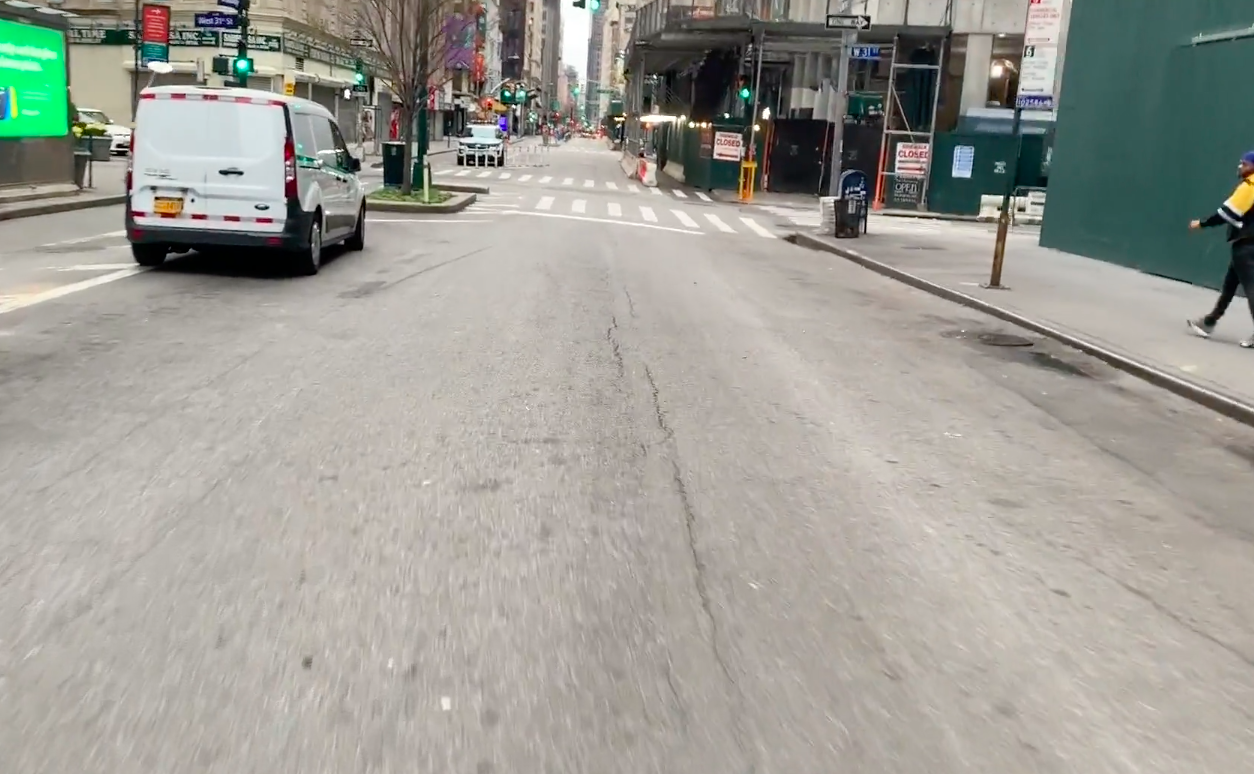The mayor is apparently listening.
Two more key roadways are part of the growing "open streets" program: portions of Broadway in Manhattan and of 34th Avenue in Jackson Heights, Queens. Residents and business owners in both communities have lobbied heavily for their streets to be included in the ongoing program to promote socially responsible recreation.
That program aims to grow to 100 miles, but started on Saturday with just 7.1 miles, mostly in and around parks.
"We're ready to go into higher gear," the mayor said on Wednesday.
The new 1.9 miles, which will open on Thursday, are:
- Broadway between 21st and 28th streets.
- Broadway between 36th to 41st streets.
- Orchard Street between Delancey and Houston streets.
- Ludlow Street between Delancey and Houston streets.
- Stanton Street between Allen and Essex streets.
- Rivington Street between Allen and Essex streets.
- Willoughby Street between Pearl and Lawrence streets.
- Lawrence Street between Fulton and Willoughby streets.
- Willis Avenue in The Bronx between 147th and 148th streets.
- 148th Street between Willis and Bergen avenues.
- 34th Avenue between 69th and 77th streets in Jackson Heights.
All segments except for the strip in Jackson Heights will be overseen and managed by local business improvement districts — which are participating as part of the city's outreach to community groups to supplement the Department of Transportation's limited staff to eventually get up to the 100-mile goal.
"These are specific sites that are being managed by local BIDs that do important work for their communities," the mayor said.
Reminder: Business Improvement Districts do not represent residents of communities. They are formed by — and raise their funds from — business owners in some commercial districts across the city, often in extremely wealthy neighborhoods (though BID boards are required to have at least one member who is a residential tenant of the district). On Broadway, several BIDs reached out to the DOT before the current open-streets program to ask the city to open up the roadway between Times Square and SoHo. (The mayor's initial refusal prompted a Streetsblog satire.)
At the launch of the open-streets program last week, Streetsblog asked DOT Commissioner Polly Trottenberg about the prospect of the open streets program becoming controlled by business groups, or have its expansion limited because it relies so much on the public or business groups. She said she hoped that would not be the case.
It’s going to be a combination. As soon as the word got out about this we are starting to hear from all kinds of groups. As you know [a reference to our coverage of Broadway], there are a lot of business improvement districts that have been excited about this, and we’re hearing from elected officials and we hope in the coming weeks to roll out a bunch of different places. Neighborhoods, though, where we think we really need to do this, but maybe there isn’t a local partner, those may be places where you will see more city staff stepping in to make sure it will happen.
Streetsblog is not the only outlet pursuing this line of inquiry:
We got to ask the mayor about it this morning. Here was his full answer:
This is a beginning. We expect to be in every kind of community. In fact, when the idea first came up, the central concern was how do we do it safely, will we have the right kind of enforcement, will we have the right kind of structures. As we have been working with this model, we are finding different ways of getting it done that we believe will keep us safe and come with structure. I really want to emphasize that my concern from the beginning was needing structure, needing enforcement, needing safety. As we are getting into it, we are finding more ways of doing it, and that is great. We also said this had to be something that focused on where the need was greatest and this approach would benefit the most. And when we worked with the City Council, one of the strands was focus on communities that have been hit the hardest and to focus on aresa around parks because demand was growing with the warmer weather. these examples today are just the beginning...and you will see different organizations that have the capacity to help make them work and give them real structure.
Whatever the plan will be going forward, BID leaders were promising an alliance with the city to manage public roadways.
"The Flatiron/23rd Street Partnership is ready to partner with the city on this important public health service for New Yorkers," James Mettham, Executive Director of the Flatiron/23rd Street Partnership said in a statement. "An open Broadway will provide New Yorkers much-needed space to walk and bike with room to safely spread out and social distance through the heart of Flatiron and NoMad. Additionally, it's critical that we continue to consider new and creative approaches to business district management and the responsible use of the public realm, like open streets, to aid our city’s economic recovery from COVID-19."
As a favor to DOT, we are offering this reminder: "Organizations wishing to have other New York City streets considered for the open streets program should reach out to openstreets@dot.nyc.gov or fill out the online survey."






